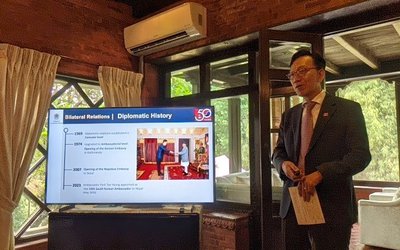
Despite some positive trends with current account surplus due to high flow of remittance and high agriculture productivity, Nepal’s GDP growth is not going to meetthe last year’s achievements.
Alongwith unfavorable weather and natural disasters, Nepal’s unstable political situation is also taking a toll on the economic growth prospects. Despite timely budget and release of funds, the capital expenditure is yet to rise with huge surplus money at Nepal’s Rastra Bank’s coffers.
The Asian Development Bank (ADB) has projected that the country's economic growth rate would be limited to 4.1 per cent in the next fiscal year.
The Asian Development Bank (ADB) has projected that the country's economic growth rate would be limited to 4.1 per cent in the next fiscal year.
Releasing the Asian Development Outlook 2015, Kenichi Yokoyama, country director of Asian Development Bank, Nepal Resident Mission, said steady growth in developing Asia continues 6.3 percent in 2015 and 2016. “India is expected to grow at 7.8 percent, faster than People Republic of China at 7.2 percent. Decline in oil price supported growth,” said Kenichi Yokoyama.
The Bank made the projection in the book - Asian Development Outlook 2015 – that it made public at a function recently. The book is about the economic performance and prospects of the 48 countries of the Asia-Pacific region.
The Nepal section of the book states that robust agriculture and remittances boosted growth and the current account surplus. It is stated that growth is expected to slow this year with an unfavorable monsoon but revive n 2016 as the weather returns to normal.
Concluding the protracted negotiations over the new constitution would strengthen the outlook. Nepal can leave behind dependence on agriculture and remittances for an economy with a higher growth trajectory if it invests more in eliminating major deficiencies in infrastructure, the book states.
GDP growth accelerated to 5.2 per cent in Fiscal Year 2014 (ended 15 July 2014) from 3.5 a year earlier. A favorable monsoon boosted agricultural output and a marked increase in remittance income, now amounting to 28.2 per cent of GDP, bolstered spending on services, which account for over half of GDP.
Growth in agriculture, at 4.7 per cent, and in services at 6.1 per cent, was the highest in the last six years. Industry again advanced only marginally at 2.7 per cent, as long hours of power outage and other supply-side constraints continued to stunt manufacturing and divert to imports and consumer spending on finished goods.
"Considering the unfavorable monsoon and the lingering political uncertainty, GDP growth is projected to slow to 4.6 per cent in Fiscal Year 2015, less than the government's revised target of 5.0 per cent," said Kenichi Yokoyama
The ADB states that the economic outlook is less favorable than in FY 2014 because agriculture output is faced with a weak monsoon and the political situation is fluid. The weak monsoon and such natural disasters as floods and landslides will affect the output of paddy, maize and millet. Industry may see better conditions in the medium term following the government's strong commitment under the FY 2015 budget to ease business regulations by introducing updated policies and legislation, though the downside risk is that the unsettled political environment will derail legislative action.
Under the heading 'Policy challenge – accelerating capital expenditure', the ADB states that capital spending has been persistently weak, with both planned and actual spending languishing far below what is required to close the infrastructure deficit, which has been estimated to require capital spending equal to between 8.2 percent and 11.8 per cent of GDP per year until 2020. Raising the amount and quality of capital expenditure is one of the country's most pressing challenges. Accelerated capital spending is needed to scale up infrastructure investments and thereby attract private investment needed for Nepal to attain higher economic growth that is both sustainable and inclusive.
In its provision and quality of infrastructure, Nepal is rated one of the least competitive countries in the world, ranked 132 of 147. This indicates that Nepal needs more and better investment to foster innovation, make the economy competitive, and enhance the efficiency of markets for goods, labor and finance.
“Given Nepal's huge infrastructure financing needs, budgeted capital spending is insufficient in itself to bridge the infrastructure deficit in such critical sectors as energy, transport, water supply and sanitation, irrigation, and telecommunications. The government's recent commitment to meet certain infrastructure needs by developing public-private partnerships is an encouraging sign that the gap can be closed,” said Yokoyama said.
Nepal’s monetary conditions remained highly accommodative in 2014.The increase in remittances inflows boosted deposits in bank liquidity and financial institution. The current account surplus is expected to be 4.7 percent of GDP on large remittances inflows despite an ever widening trade deficit.
Overviewing the mid-year of Fiscal year 2015, Chandan Sapkota of ADB Resident Mission said late and subnormal monsoon, political uncertainty, reported deceleration of remittances inflows and large gap between investment commitment and annual flows will likely impact growth.
Sapkota said that the fiscal sector scenario is also not favorable as the budget as utilization is lower than mid-year 2014, lower capital budget utilization rate with 12.6 percent less than last year’s 13.5 percent, increasing budget surplus, robust revenue performance and high bunching of capital spending.
Although Nepal’s oil bill decreases, the non-oil bill increases. This is the reason Nepal’s current account and balance of payments surplus dropped.
- NEPAL-THAILAND: Joint Business Council
- Apr 13, 2025
- BIMSTEC SUMMIT: Nepal’s Stand
- Apr 11, 2025
- IME GROUP: Expands Into Paper Industry
- Mar 24, 2025
- CPN UML: Instigated By India
- Mar 23, 2025
- ADB’S CHIEF ECONOMIST: Nepal Reduces Poverty
- Mar 11, 2025















